Overview
- Description
- Consists of documents and copies related to the Holocaust experiences of Gerhard Maschkowski, originally of Elbing, Germany. Includes a poem written on the occasion of his 1938 bar mitzvah, identity cards, and information about his experiences in Neuendorf and in Auschwitz. Also includes documents related to Ursula Naumann Maschkowski, including photographic postcards of Theresienstadt and postcards sent to the Naumann family while they were imprisoned there. Also includes material related to the Deggendorf displaced persons camp, where Gerhard and Ursula met; photographic print: black and white image of men and women standing in front of and inside boxcar; captioned on verso: "February 1947 on the way from Munich to Bremerhave to the U.S."; in English; donor is one of the men standing in the doorway (he thinks he is on the far right).
- Date
-
inclusive:
1938-2005
- Credit Line
- United States Holocaust Memorial Museum Collection, Gift of Gerhard Maschkowski
- Collection Creator
- Gerhard Maschkowski
- Biography
-
Gerhard Maschkowski was born on May 19, 1925 in Elbing, Germany, (now Elbląg, Poland) to Jewish parents, Arthur and Herta Imber Maschkowski. Arthur was born on January 5, 1895, in Gross-Statsin. He served in the German military during World War I (1914-1918), and was injured and lost both eyes. Herta was born on August 16, 1896, in Thorn, Germany. Arthur, and sometimes Herta, worked as a typist for a copy service. Gerhard had an older brother, Siegfried, born on August 23, 1922, in Danzig.. In 1933, the Nazi dictatorship took control of Germany. Policies to persecute the Jewish population were implemented across Germany.
On November 9-10, 1938, Kristallnacht, Gerhard saw Jewish stores looted and burned. He was beaten up in school for being Jewish and then no longer allowed to attend. In 1939, Siegfried left for Palestine. Gerhard’s parents sent him to an agricultural school in Ahlem, supposedly to learn skills to emigrate. But soon after he arrived, Gerhard and the other students were taken to Jessen-Mühle labor camp near Sommerfeld (Lubsko, Poland) to do agricultural and civic forced labor. The farm work was hard but they were well fed. In May 1941, they were transferred to Neuendorf labor camp near Berlin where they dug ditches and graves and did road construction for the city. On April 8, 1943, Gerhard was taken by the Gestapo and sent to Auschwitz concentration camp, arriving there on April 20, 1943. He was shaved, tattooed, and given five items: prisoner uniform cap, jacket, pants, a bowl, and a spoon. Gerhard was selected for forced labor and sent to Auschwitz III - Monowitz (Buna) concentration camp. He was assigned to a work detail for an IG Farben factory, first digging ditches and laying cement. With assistance from kapos, who helped fellow Zionists like Gerhard, he got into the electrician detail, laying cable. He learned to ignore the atrocities such as hangings that were normal parts of camp life. Speaking German was an advantage, which helped keep him on the factory detail. As people died, new ones arrived to take their place. Gerhard was able to earn extra food for cleaning the block leader's area. He sometimes had items to trade with other inmates and he formed a friendship with a fellow prisoner Freddy Diamant, who got food for Gerhard and two friends, Benjamin Fengersch and Elie Hyman. In late 1944, the bombings began near the camp. In January 1945, Soviet forces were approaching and the Germans emptied the camp, sending the prisoners on a four month long death march. Except for a brief stay circa late January in Gleiwitz concentration camp, his group was led from place to place throughout Germany and Czechoslovakia. They were kept moving, either on foot or on a coal train. If you stumbled, you were shot. At one point when it was snowing, they were put in a mine shaft. As the air ran out, people would run outside and were shot. Gerhard and his friends stayed in the back, mouths to the ground, pulling oxygen from the earth. Gerhard became numb with cold, but his friends kept him from freezing to death.
In late April 1945, he was liberated during the march by the Red Army near Breslau (now Wrocław, Poland). Gerhard weighed only seventy pounds and could not walk. He was placed in a Catholic hospital and cared for by nuns. During the several months long recovery, Gerhard befriended a Russian soldier, who showed him stores of food the German occupying forces of Breslau had gathered. Gerhard arranged for much of the food to be transferred to the hospital. After his recovery, Gerhard got a letter telling him that his parents had survived. They had been deported in December 1942 to Theresienstadt ghetto-labor camp in German occupied Czechoslovakia because of Arthur’s special status as a wounded war veteran. The camp was liberated in May 1945. The family reunited and lived in Deggendorf displaced persons camp in Germany. While at Deggendorf, Gerhard met his future wife, Ursula Naumann. Ursula was born in Berlin on December 26, 1925, to a Catholic father and a Jewish mother, Margarete. The whole family was considered Jewish. Margarete, Ursula, and Ursula’s sister Hannelore were interned in Theresienstadt. Their father was deported to Auschwitz, where he perished. In March 1947, Gerhard and Ursula emigrated to the United States aboard the Marine Marlin. They married on May 27, 1947, in the morning before going to work. Margarete and Hannelore joined them in September. Gerhard's parents remained in Germany. Gerhard and Ursula moved to Florida, where Gerhard opened an auto repair shop. They had a daughter and two sons. In 1979, the couple settled in California. Ursula, 80, passed away in April 2005.
Physical Details
- Extent
-
2 folders
Rights & Restrictions
- Conditions on Access
- There are no known restrictions on access to this material.
- Conditions on Use
- Material(s) in this collection may be protected by copyright and/or related rights. You do not require further permission from the Museum to use this material. The user is solely responsible for making a determination as to if and how the material may be used.
Keywords & Subjects
- Geographic Name
- Elbing (Germany)
Administrative Notes
- Holder of Originals
-
United States Holocaust Memorial Museum
- Legal Status
- Permanent Collection
- Provenance
- Gerhard Maschkowski donated this collection to the United States Holocaust Memorial Museum in 2013.
- Record last modified:
- 2024-01-23 10:07:36
- This page:
- https://collections.ushmm.org/search/catalog/irn69541
Download & Licensing
- In Copyright - Use Permitted
- Terms of Use
- This record is not digitized and cannot be downloaded online.
In-Person Research
- Request 7 Days in Advance of Visit
- Plan a Research Visit
-
Request in Shapell Center Reading Room
Bowie, MD
Contact Us
Also in Gerhard and Ursula Naumann Maschkowski collection
The collection consists of scrip, documents, and photographs relating to the experiences of Gerhard Maschkowski before the Holocaust in Elbing, Germany, and during the Holocaust in Neuendorf and Auschwitz concentration camps, and of documents, correspondence, and photographic postcards relating to the experiences of Ursula Naumann (later Maschkowski) and her family during the Holocaust in Theresienstadt, and to both Gerhard and Ursula after the war in Deggendorf displaced persons camp, where they met, and in the United States where they later settled.
Date: 1938-2005
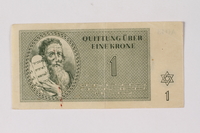
Theresienstadt ghetto-labor camp scrip, 1 krone note, owned by a German Jewish survivor
Object
Theresienstadt scrip, valued at 1 (eine) krone, belonging to Gerhard Maschkowski. Gerhard was not interned in the ghetto-labor camp in German occupied Czechoslovakia, but his wife Ursula Naumann and his parents were there several years. Inmates were not allowed to have currency and the SS ordered the Jewish Council to design scrip for use only in the camp. Produced in 7 denominations: 1, 2, 5, 10, 20, 50, 100, it was issued to create a false appearance of normalcy in the camp. There was nothing to obtain with the scrip. Gerhard lived with his parents Arthur and Herta, and brother Siegfried in Elbing, Germany. From 1933, the country was governed by a Nazi dictatorship that persecuted Jews. Siegfried left for Palestine in 1939 and Gerhard was sent to agricultural school. Soon after arrival, Gerhard and the others were sent to Jessenmühle labor camp. In 1941, they were transferred to Neuendorf labor camp. In April 1943, he was deported to Auschwitz, and then to Auschwitz III, Buna-Monowitz. In January 1945, the camp was evacuated. The prisoners spent several months on a death march through Czechoslovakia and Germany. In late April 1945, he was liberated by the Red Army near Breslau, weighing only seventy pounds. He was hospitalized and, after recovering, learned that his parents had survived Theresienstadt. They were reunited in Deggendorf displaced persons camp in Germany.
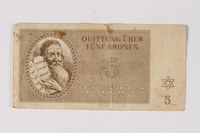
Theresienstadt ghetto-labor camp scrip, 5 kronen note, owned by a German Jewish survivor
Object
Theresienstadt scrip, valued at 5 [funf] kronen, belonging to Gerhard Maschkowski. Gerhard was not interned in the ghetto-labor camp in German occupied Czechoslovakia, but his wife Ursula Naumann and his parents were there several years. Inmates were not allowed to have currency and the SS ordered the Jewish Council to design scrip for use only in the camp. Produced in 7 denominations: 1, 2, 5, 10, 20, 50, 100, it was issued to create a false appearance of normalcy in the camp. There was nothing to obtain with the scrip. Gerhard lived with his parents Arthur and Herta, and brother Siegfried in Elbing, Germany. From 1933, the country was governed by a Nazi dictatorship that persecuted Jews. Siegfried left for Palestine in 1939 and Gerhard was sent to agricultural school. Soon after arrival, Gerhard and the others were sent to Jessenmühle labor camp. In 1941, they were transferred to Neuendorf labor camp. In April 1943, he was deported to Auschwitz, and then to Auschwitz III, Buna-Monowitz. In January 1945, the camp was evacuated. The prisoners spent several months on a death march through Czechoslovakia and Germany. In late April 1945, he was liberated by the Red Army near Breslau, weighing only seventy pounds. He was hospitalized and, after recovering, learned that his parents had survived Theresienstadt. They were reunited in Deggendorf displaced persons camp in Germany.
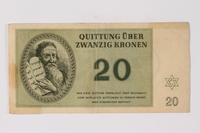
Theresienstadt ghetto-labor camp scrip, 20 kronen note, owned by a German Jewish survivor
Object
Theresienstadt scrip, valued at 20 [zwanzig] kronen, belonging to Gerhard Maschkowski. Gerhard was not interned in the ghetto-labor camp in German occupied Czechoslovakia, but his wife Ursula Naumann and his parents were there several years. Inmates were not allowed to have currency and the SS ordered the Jewish Council to design scrip for use only in the camp. Produced in 7 denominations: 1, 2, 5, 10, 20, 50, 100, it was issued to create a false appearance of normalcy in the camp. There was nothing to obtain with the scrip. Gerhard lived with his parents Arthur and Herta, and brother Siegfried in Elbing, Germany. From 1933, the country was governed by a Nazi dictatorship that persecuted Jews. Siegfried left for Palestine in 1939 and Gerhard was sent to agricultural school. Soon after arrival, Gerhard and the others were sent to Jessenmühle labor camp. In 1941, they were transferred to Neuendorf labor camp. In April 1943, he was deported to Auschwitz, and then to Auschwitz III, Buna-Monowitz. In January 1945, the camp was evacuated. The prisoners spent several months on a death march through Czechoslovakia and Germany. In late April 1945, he was liberated by the Red Army near Breslau, weighing only seventy pounds. He was hospitalized and, after recovering, learned that his parents had survived Theresienstadt. They were reunited in Deggendorf displaced persons camp in Germany.
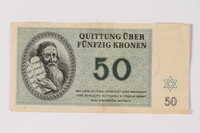
Theresienstadt ghetto-labor camp scrip, 50 kronen note, owned by a German Jewish survivor
Object
Theresienstadt scrip, valued at 50 [funfzig] kronen, belonging to Gerhard Maschkowski. Gerhard was not interned in the ghetto-labor camp in German occupied Czechoslovakia, but his wife Ursula Naumann and his parents were there several years. Inmates were not allowed to have currency and the SS ordered the Jewish Council to design scrip for use only in the camp. Produced in 7 denominations: 1, 2, 5, 10, 20, 50, 100, it was issued to create a false appearance of normalcy in the camp. There was nothing to obtain with the scrip. Gerhard lived with his parents Arthur and Herta, and brother Siegfried in Elbing, Germany. From 1933, the country was governed by a Nazi dictatorship that persecuted Jews. Siegfried left for Palestine in 1939 and Gerhard was sent to agricultural school. Soon after arrival, Gerhard and the others were sent to Jessenmühle labor camp. In 1941, they were transferred to Neuendorf labor camp. In April 1943, he was deported to Auschwitz, and then to Auschwitz III, Buna-Monowitz. In January 1945, the camp was evacuated. The prisoners spent several months on a death march through Czechoslovakia and Germany. In late April 1945, he was liberated by the Red Army near Breslau, weighing only seventy pounds. He was hospitalized and, after recovering, learned that his parents had survived Theresienstadt. They were reunited in Deggendorf displaced persons camp in Germany.
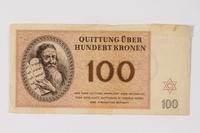
Theresienstadt ghetto-labor camp scrip, 100 kronen note, owned by a German Jewish survivor
Object
Theresienstadt scrip, valued at 500 [eine hundert] kronen, belonging to Gerhard Maschkowski. Gerhard was not interned in the ghetto-labor camp in German occupied Czechoslovakia, but his wife Ursula Naumann and his parents were there several years. Inmates were not allowed to have currency and the SS ordered the Jewish Council to design scrip for use only in the camp. Produced in 7 denominations: 1, 2, 5, 10, 20, 50, 100, it was issued to create a false appearance of normalcy in the camp. There was nothing to obtain with the scrip. Gerhard lived with his parents Arthur and Herta, and brother Siegfried in Elbing, Germany. From 1933, the country was governed by a Nazi dictatorship that persecuted Jews. Siegfried left for Palestine in 1939 and Gerhard was sent to agricultural school. Soon after arrival, Gerhard and the others were sent to Jessenmühle labor camp. In 1941, they were transferred to Neuendorf labor camp. In April 1943, he was deported to Auschwitz, and then to Auschwitz III, Buna-Monowitz. In January 1945, the camp was evacuated. The prisoners spent several months on a death march through Czechoslovakia and Germany. In late April 1945, he was liberated by the Red Army near Breslau, weighing only seventy pounds. He was hospitalized and, after recovering, learned that his parents had survived Theresienstadt. They were reunited in Deggendorf displaced persons camp in Germany.
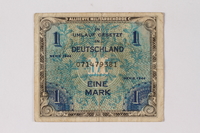
Allied Military Authority currency, 1 mark, for use in Germany, acquired by a German Jewish survivor
Object
Allied Military Authority currency, 1 mark, for use in Germany, acquired by Gerhard Maschkowski, presumably while living in Deggendorf displaced persons camp after the war. Gerhard lived with his parents Arthur and Herta, and brother Siegfried in Elbing, Germany. From 1933, the country was governed by a Nazi dictatorship that persecuted Jews. Siegfried left for Palestine in 1939 and Gerhard was sent to agricultural school. Soon after arrival, Gerhard and the others were sent to Jessenmühle labor camp. In 1941, they were transferred to Neuendorf labor camp. In April 1943, he was deported to Auschwitz, and then to Auschwitz III, Buna-Monowitz. In January 1945, the camp was evacuated. The prisoners spent several months on a death march through Czechoslovakia and Germany. In late April 1945, he was liberated by the Red Army near Breslau, weighing only seventy pounds. He was hospitalized and, after recovering, learned that his parents had survived Theresienstadt. They were reunited in Deggendorf displaced persons camp in Germany.



